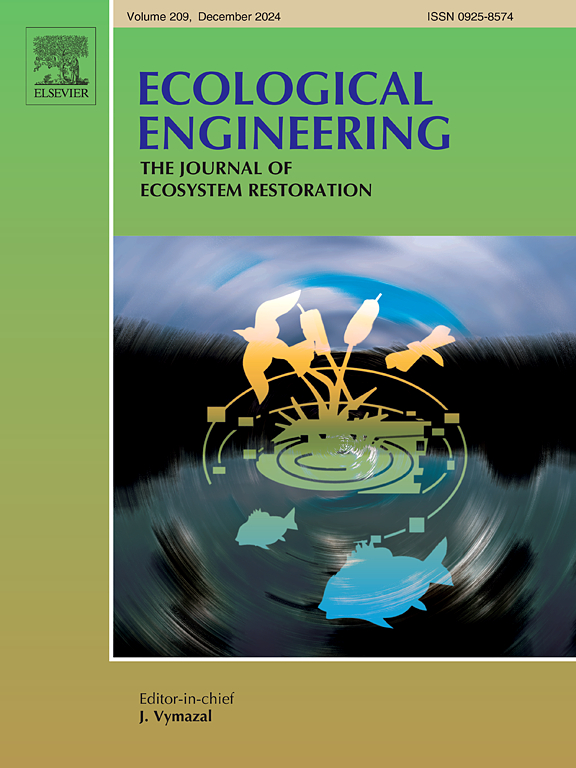天津市8-14年复垦后土壤种子库特征及植被演替影响因素
IF 4.1
2区 环境科学与生态学
Q1 ECOLOGY
引用次数: 0
摘要
填海工程对滨海湿地生态系统和自然海岸线造成了严重破坏。基于自然的解决方案对于填海地区的生态恢复至关重要,特别是在促进植被恢复方面。但目前围垦区植被恢复主要依靠人工绿化,对自然植被恢复缺乏深刻认识。采用野外调查和遥感分析相结合的方法,对垦区8 ~ 14年的自然生态演替进行了地上植物群落和土壤种子库的评价。评价土壤和种子特性,计算植物-土壤-种子库质量指数(QI)。利用结构方程模型(SEM)探讨植被、土壤性质、种子库与QI之间的关系。结果表明:经过8 ~ 14年的自然恢复,地上植物物种多样性保持稳定,表明木本植物在稳定群落组成中起着关键作用。但12年后,种子丰富度呈下降趋势,以风和自繁殖为主要传播方式。此外,自然植被恢复的潜力随着时间的推移而增加。土壤全盐度(TS)、速效氮(AN)和速效磷(AP)是影响植物和地上植被自然演替的主要驱动因素。因此,垦区自然植被恢复潜力随时间增加,在空间上保持稳定,主要受土壤因子驱动。本研究可为填海造地植被的自然恢复提供典型案例。本文章由计算机程序翻译,如有差异,请以英文原文为准。

Soil seed bank characteristics and influencing factors of vegetation succession after 8–14 years reclamation projects in Tianjin, China
Sea reclamation projects have caused serious damage to coastal wetland ecosystems and natural coastlines. Nature-based solutions are critical for ecological restoration in reclaimed areas, especially in promoting vegetation recovery. However, current vegetation restoration in reclaimed areas mainly relies on artificial greening, without deep insights on the restoration of natural vegetation. This study assessed aboveground plant communities and soil seed banks (SSBs) over 8–14 years of natural ecological succession in the reclamation area, using field surveys and remote sensing analyses. Soil and seed characteristics were evaluated, and a plant-soil-seed bank quality index (QI) was calculated. Structural equation modeling (SEM) was used to explore relationships between vegetation, soil properties, seed bank, and QI. The results show that after 8–14 years of natural recovery, the diversity of aboveground plant species remained stable, indicating that woody plants play a key role in stabilizing community composition. However, the species richness of the SSBs decreased after 12 years, with wind and self-reproduction as dominant modes of seed dispersal. Moreover, the potential for natural vegetation recovery increased over time. Soil total salinity (TS), available nitrogen (AN), and available phosphorus (AP) were identified as the main drivers affecting the natural succession of SSBs and aboveground vegetation. Therefore, the potential for natural vegetation recovery in reclamation areas increases over time, remains stable in space, and was mainly driven by soil factors. This study can provide a typical case for the natural restoration of vegetation in sea reclamation areas.
求助全文
通过发布文献求助,成功后即可免费获取论文全文。
去求助
来源期刊

Ecological Engineering
环境科学-工程:环境
CiteScore
8.00
自引率
5.30%
发文量
293
审稿时长
57 days
期刊介绍:
Ecological engineering has been defined as the design of ecosystems for the mutual benefit of humans and nature. The journal is meant for ecologists who, because of their research interests or occupation, are involved in designing, monitoring, or restoring ecosystems, and can serve as a bridge between ecologists and engineers.
Specific topics covered in the journal include: habitat reconstruction; ecotechnology; synthetic ecology; bioengineering; restoration ecology; ecology conservation; ecosystem rehabilitation; stream and river restoration; reclamation ecology; non-renewable resource conservation. Descriptions of specific applications of ecological engineering are acceptable only when situated within context of adding novelty to current research and emphasizing ecosystem restoration. We do not accept purely descriptive reports on ecosystem structures (such as vegetation surveys), purely physical assessment of materials that can be used for ecological restoration, small-model studies carried out in the laboratory or greenhouse with artificial (waste)water or crop studies, or case studies on conventional wastewater treatment and eutrophication that do not offer an ecosystem restoration approach within the paper.
 求助内容:
求助内容: 应助结果提醒方式:
应助结果提醒方式:


